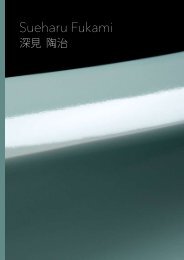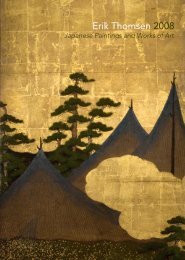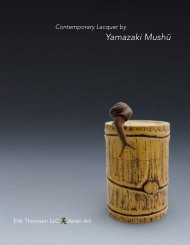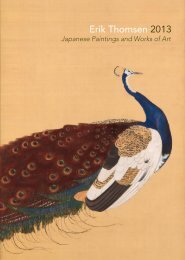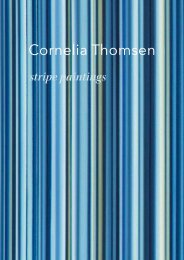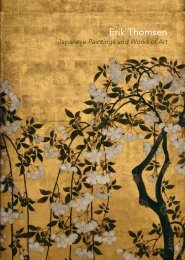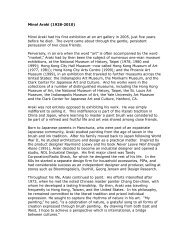View publication (pdf file 6.5 mb) - Erik Thomsen
View publication (pdf file 6.5 mb) - Erik Thomsen
View publication (pdf file 6.5 mb) - Erik Thomsen
- No tags were found...
You also want an ePaper? Increase the reach of your titles
YUMPU automatically turns print PDFs into web optimized ePapers that Google loves.
12Sengai Gibon 仙 厓 義 梵 (1750 –1837)The Hakata Top Crossing a StringEdo period (1615 –1868), circa 1820H 14 ¼" × W 21½" (incl. mounting 49 ½" × 24 ¾")(36.3 cm × 54.7 cm, 126 cm × 62.6 cm)Hanging scroll, ink on silkSeal on painting: Sengai 仙 厓Painting inscription: Ladies and gentlemen, if youare looking for wealth and fortune, then look at thespinning top from Hakata, actually crossing a string.Careful, careful! Look here, if you lower the stringthen it will come spinning, spinning toward you. Ifyou raise it a little, then it will go spinning away, allthe way to the next town. So be careful of how youhold your string. Why don’t you try?東 西 々々 福 徳 を 願 ふ / なら 博 多 古 まの / 糸 渡 りアレ々々手 元 を / さくれハこちらへ / ころ々々ころんてこさる /手 元 を 少 高 むれハ / 向 ふ 町 へさけて 行 / 手 元 におきを 付 られませ / ヨウ々々Box, outer inscription, top: »Brushed by the MonkSengai. Painting with Inscription of the Hakata TopCrossing a String« Hakata koma ito watari no gasan:Sengai oshō hitsu 博 多 古 満 糸 渡 りの 画 賛 仙 厓 和 尚 筆1Box, inner inscription:»Title inscribed by the 70-year old Tōkō«shichijū-ō Tōkō dai shirusu 七 十 翁 韜 光 題 署We see here a strikingly humorous ink painting bySengai, one of the great Edo period Zen Buddhistartists. 2 Sengai depicts a street performer who balancesa spinning top for an audience. The performer,the God of Luck Daikoku in disguise, balances thetop on a string which is tied to bales of rice—a referenceto wealth in a time when wealth was generallymeasured in nu<strong>mb</strong>er of rice bales. There is also alarge bag under the top, referring to the riches thatmay be available with luck.The joke here is how the important matter of fortunein life can be reduced to a spinning top plied by astreet performer. The strangeness of the situation isfurther reinforced by the colloquial banter of thestreet performer, as he tries to gather a crowd (seeinscription). Of course, Sengai provides a seriousedge to his joke: just as a slight movement to thehand can make the difference between the top arriving(good luck) and the top flying away (bad luck),our lives and fortunes are also easily influencedby outside events. That is why we need to place ourfaith in permanent, immovable things, such as theBuddha.Sengai made a nu<strong>mb</strong>er of paintings of street performersin order to illustrate his allegories. 3 Hewas clearly interested in the life of the commonersaround him and saw the humor in daily life as aneffective way to make his serious points about life,religion and fate to the people who visited histemple. The fact that this painting is done on silk,a rare material for Sengai, indicates that it wasmade not for a common visitor but for an importantperson. For Sengai the mixture of elite and commonwas entirely in character—in his paintings heaimed at the common human condition of all, regardlessof social status. 4Other examples of the spinning top performer areknown. One example with a similar inscription is inthe Idemitsu Collection 5 , a work that toured Europein one of the pioneering Edo-period Zen paintingexhibitions in 1964. 6 Other examples show similarcompositions, yet never exactly the same inscriptionand Sengai was apparently happy to keep changingthe wording of his message. 7The box is inscribed and authenticated by the ZenBuddhist abbot Tōkō Genjō. After a longer time ofinactivity, Sengai’s old temple, the Shōfukuji 聖 福 寺 ,was revitalized by Tōkō. He was also active as a collectorof Sengai paintings. He became known as theleading connoisseur of Sengai, and scrolls withhis inscriptions are eagerly sought after by Sengaicollectors. 858



